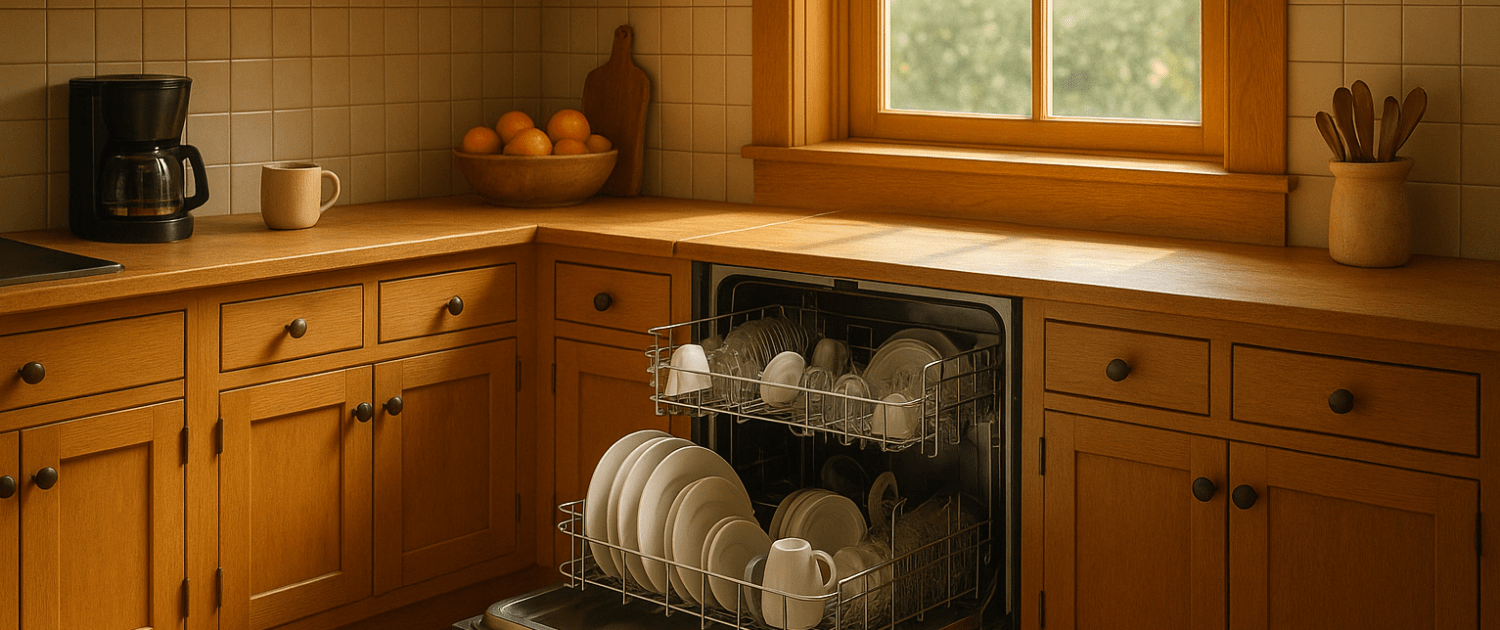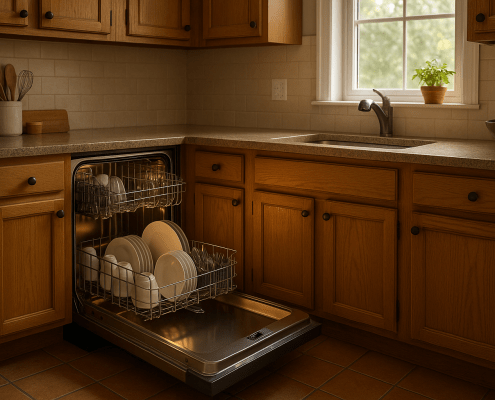How to replace drain pump WD19X24829 on a GE dishwasher
Steven E / Thursday May 15, 2025
Having clean dishes is an essential part of any home. But when your GE dishwasher fails to adequately drain away dirty water, dishes come out still dirty. The culprit is likely a faulty drain pump. Replacing this component is an easy DIY fix that anyone can tackle in about an hour. In this guide, we’ll walk through the entire drain pump replacement process for a GE dishwasher. Follow along as we go over the basics of how the pump works, prep steps, removal and installation, and finally testing your repair.
The information in this article may not apply to your specific appliance model. We recommend consulting your manufacturer’s documentation or contact us with any questions.
Introduction to the drain pump
The drain pump on a GE dishwasher is responsible for pumping out the dirty wash water during and after cycles. It contains an impeller that spins to suction water and push it through the hose to the home’s drain lines. Over time, drain pumps can fail in a few ways:
- The impeller blades get clogged with debris or minerals, preventing proper water flow.
- The motor stops running, so the impeller no longer spins.
- Leaks develop in the pump housing, leading to puddles under the dishwasher.
Any of these issues mean it’s time to replace your failing or leaking drain pump. Doing this as a DIY repair can save you money compared to calling a technician.
Before starting, make sure to turn off the power to the dishwasher at the breaker box. You’ll also want to shut off the hot water supply line underneath the sink.
Materials Needed
Replacing the drain pump requires just a few basic tools and parts. Here are the key items you’ll need for this repair:
- GE drain pump kit (WD19X24829)
- Phillips head screwdriver
- 5/8″ wrench
- 5/16″ nut driver
- Small flathead screwdriver
- Towels or buckets
- Flashlight
Be sure to order the specific drain pump kit made for your GE dishwasher model.
Safety precautions
Safety should always be a priority when working on any appliance. Here are a few practical tips to help you stay safe:
- Turn off the power to the appliance by unplugging it or switching off the circuit breaker before starting any maintenance or repairs. This protects you from the risk of electric shock.
- Wear insulated gloves to shield your hands from sharp edges, pinching hazards, or debris.
- Work at a steady pace and take your time to avoid accidents or injuries.
- Make sure your workspace is well-lit so you can clearly see and access the parts you’re working on.
- Keep the area clear of clutter, and ensure children and pets stay out of the workspace.
- Never handle internal parts with wet hands. Check that both your hands and the work area are completely dry.
- Refer to your appliance’s user manual for any specific instructions or safety guidelines related to the part or repair.
- Handle parts gently to avoid damage to the appliance or potential injuries from applying too much force.
- Use safety glasses when dealing with chemicals, dust, or large debris to protect your eyes from harm.
- If the appliance was recently used, give it enough time to cool down before working on any heated components.
- Take photos or notes of wiring connections and terminals before disconnecting anything to make reassembly easier.
- Avoid touching exposed wires or terminals. If you must handle wires, use non-conductive tools or wear insulated gloves to minimize the risk of electrical shock.
Preparing the dishwasher access
The first step is gaining access to the underside of the dishwasher so we can detach the water lines and pull the unit out.
- Remove the lower rack. Open the dishwasher, then pull out the lower rack by the front handle. Lift it completely out and set it aside.
- Disconnect water and drain lines. Under the sink, detach the hot water line and drain the hose from the disposal or air gap device. Have a towel ready to catch drips.
- Unfasten from the underside of the counter. Use a Phillips screwdriver to remove the screws securing the plastic brackets to the countertop.
- Pull the dishwasher out. Carefully open the door fully and grasp the body frame. Slowly pull the dishwasher completely out from the cabinet.
With the back now exposed, you can access the inner workings.
Removing the old drain pump
Let’s begin dismantling components to remove the faulty drain pump:
- Lay the dishwasher down. Gently tip the dishwasher onto its side. Place towels beneath it to prevent surface damage.
- Remove the drip pan. Slide the plastic drip pan toward the front to release it. Set it aside to access the sump.
- Disconnect the wiring harness. Find the wiring clip on the rear of the pump housing. Depress the tab with a flathead screwdriver and detach the plug.
- Loosen hose clamps. Use a nut driver to loosen the metal hose clamps on the pump’s inlet and outlet.
- Detach pump hoses. Once the clamps are loose, pull the rubber hoses off the pump ports. Have towels ready to catch water.
- Release the pump from the base. Locate the mounting pin and pull it straight up to detach. Now the pump can be removed.
- Inspect the old pump. Check for cracks in the plastic housing, stuck impeller, or corrosion. A replacement is likely needed.
Installing the new GE drain pump
With the old pump removed, it’s time to install the new replacement pump:
- Insert mounting pin. Line up the new pump’s pin slot with the hole on the base. Push straight down until seated firmly.
- Attach inlet hose. Wet the hose end to ease sliding it onto the port. Make sure it’s pushed on completely before tightening the clamp.
- Connect outlet hose. Repeat to securely connect the outlet hose to the other pump port and clamp it.
- Reattach the wiring plug. Line up the colored wires and push the harness plug into the port until it clicks and locks.
- Replace the drip pan. Confirm the pan orientates correctly, then press in place so the tabs click. Slide it backward to lock.
- Return the dishwasher upright. Slowly lift the dishwasher back onto its feet. Make sure no tubes or wires are caught or pinched underneath.
Reinstalling the dishwasher
Now we just need to secure the appliance back into the cabinetry and reconnect everything:
- Feed hoses into the opening. Push the dishwasher about halfway in, then feed the hoses through the opening under the counter.
- Fasten the dishwasher to the underside of the counter. Align the brackets and use the Phillips screwdriver to insert and tighten the retaining screws.
- Connect water and drain lines. Attach the drain hose to the disposal/air gap and tighten the clamp. Also, reconnect the hot water line and turn on the shut-off valve.
- Replace the lower rack. Slide the rack back into the rails on the door until it clicks into place.
- Restore power. Plug the dishwasher electrical cord back into the junction box outlet.
Testing the repair
The final steps are confirming the new pump works properly:
- Check for leaks. Verify no water is dripping from the pump or hoses by running a quick rinse cycle. Turn off the power immediately if leaks occur.
- Confirm proper drainage. Run a normal wash cycle and make sure the dishwasher drains fully and doesn’t leave standing water inside.
- Test pump noise. Listen as the pump activates to ensure the impeller is spinning and making normal sounds. Loud grinding could mean a defective replacement.
- Verify clean dishes. Finally, verify a full cycle now properly cleans dishes. The drain pump replacement should have you back washing effectively.
Where To Find Us
If you need any replacement parts for your appliances, you can enter your model number at AppliancePartsPros.com to locate and order them quickly. Most orders arrive in just two business days, and we have tons of great information in our repair help section and YouTube videos to help you troubleshoot.
Stay connected with the latest DIY tips, tutorial videos, and repair guides by following us on Facebook, Instagram, and Twitter. We love hearing about your repair stories and successes. If you need more help or want personalized guidance, feel free to reach out. We’re ready to help you take on your next project with confidence!
With nearly a decade of experience in providing top-notch customer service regarding appliance parts and repair, Steven enjoys sharing practical advice, troubleshooting tips, and interesting information to help readers stay informed.





